并查集
1.并查集问题中集合存储如何实现?
可以用树结构表示集合,每个节点代表一个集合元素
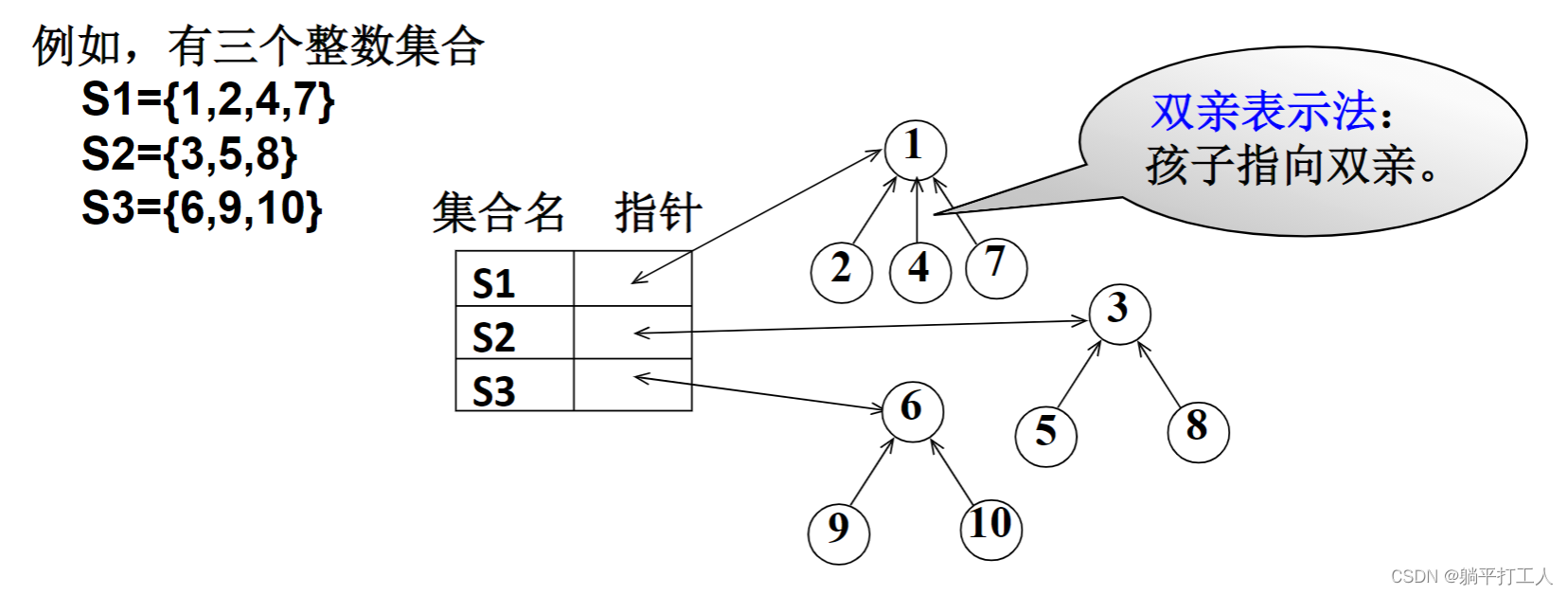
采用数组形式存储

负数表示根结点;非负数表示双亲结点的下标。

数组中每个元素的类型描述为:
typedef struct {
ElementType Data;
int Parent;//相当于指针,表示这个节点的父节点在集合中的位置
} SetType;
2 .集合运算
(1)查找某个元素所在的集合(用根结点表示)
int Find(SetType S[], ElementType X)
{ //在数组S中查找值为X的元素所属的集合
//Maxsize是全局变量,为数组S的最大长度
int i;
for (i=0 ; i < Maxsize && S[i].Data != X; i++); //当S[i].Data = X时,循环结束,i为X的位置下标
if(i >= Maxsize) return -1; //未找到X,返回-1 则i为根节点的下标
for (; S[i].Parent >= 0; i = S[i].Parent); //如果i < Maxsize,寻找父结点,直到S[i].Parent < 0为止(根结点的Parent为-1)
return i; //找到X所属集合,返回树根结点在数组S中的下标
}
(2)集合的并运算
①分别找到X1和X2两个元素所在集合树的根结点;
② 如果它们不同根,则将其中一个根结点的父结点指针设置成另一个根结点的数组下标。
void Union(SetType S[ ], ElementType X1, ElementType X2)
{
int Root1, Root2;
Root1 = Find(S, X1);
Root2 = ind(S, X2);
if (Root1 != Root2) //当x1和x2不属于同一子集时,才需要合并
S[Root2].Parent = Root1;
}
为了改善合并以后的查找性能,可以采用小的集合合并到相对大的集合中。(修改Union函数)
void Union(SetType S, SetName Root1, SetName Root2)
{ //这里默认Root1和Root2是不同集合的根结点
//保证小集合并入大集合
if ( S[Root2] < S[Root1] ) { //如果集合2比较大
S[Root2] += S[Root1]; //集合1并入集合2
S[Root1] = Root2;
}
else { //如果集合1比较大
S[Root1] += S[Root2]; //集合2并入集合1
S[Root2] = Root1;
}
}
3. 并查集的实现
数组存储形式实现并查集的代码如下所示。
#include<iostream>
using namespace std;
#define MaxSize 1000
typedef int ElementType;
typedef struct {
ElementType Data; // 存值
int Parent; // 指向父结点
}SetType;
// 查找
int Find(SetType S[], ElementType X)
{
int i;
for (i = 0; i < MaxSize && S[i].Data != X; i++); // 找到数组中该值对应的下标
if (MaxSize <= i) // 如果没有找到,返回 -1
return -1;
for (; S[i].Parent >= 0; i = S[i].Parent); // 找到该结点的根结点
return i; // 返回根结点在数组S中的下标
}
// 并
void Union(SetType S[], ElementType X1, ElementType X2)
{
int root1 = Find(S, X1); // 找到 X1 的根结点下标
int root2 = Find(S, X2); // 找到 X2 的根结点下标
// 如果根结点的下标不同,说明不是一个集合
if (root1 != root2)
{
S[root1].Parent = root2; // 把X1挂到X2的集合
}
}
int main()
{
SetType S[MaxSize];
// 初始化数组,父结点全部指向-1
for (int i = 0; i < MaxSize; i++)
{
S[i].Data = i + 1;
S[i].Parent = -1;
}
cout << Find(S, 5) << endl;
Union(S, 3, 5);
cout << Find(S, 4) << endl;
cout << Find(S, 3) << endl;
Union(S, 1, 3);
Union(S, 2, 4);
Union(S, 8, 6);
cout << Find(S, 6) << endl;
cout << Find(S, 8) << endl;
system("pause");
return 0;
}
代码运行结果如下图所示。

4.集合的优化
为什么要优化?
问题中每查找一次都要遍历n个节点,若想把所有元素都遍历一遍则时间复杂度为O(n^2)。效率低,故需要进行优化。
优化方案
任何有限集合的N个元素都能映射为0~N-1.故可以大小为N的数组的下标来表示集合元素的位置,数组中存放的值则为其父节点的位置。

代码实现
1.并查集的表示形式
#define MaxSize 100
typedef int ElementType;
typedef int SetName;
typedef ElementType SetType[MaxSize];
2.查找和合并操作
SetName Find(SetType S, ElementType X) {//查找某个元素的根节点
for (; S[X] >= 0; X = S[X]) {
//默认集合元素全部初始化为-1
return X;
}
}void Union(SetType S, SetName Root1, SetName Root2) {
//这里root1和root2是不同节点的根节点
S[Root2] = S[Root1];
}例题
输入连接的计算机的数量n,分别编号为1,2,3···n,然后输入要进行的操作。
C表示Check两台计算机是否链接,若链接则输出“Yes”否则输出“No”
I表示Inter即连接两台计算机。
S表示操作结束,退出。
最后判断有几个连接网。(即有计算机相互连通的net有几个,若某个计算机没有和别的计算机联通,则按照它与自己连通来看,也算作一个net)
输入样例:
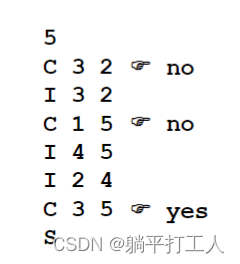
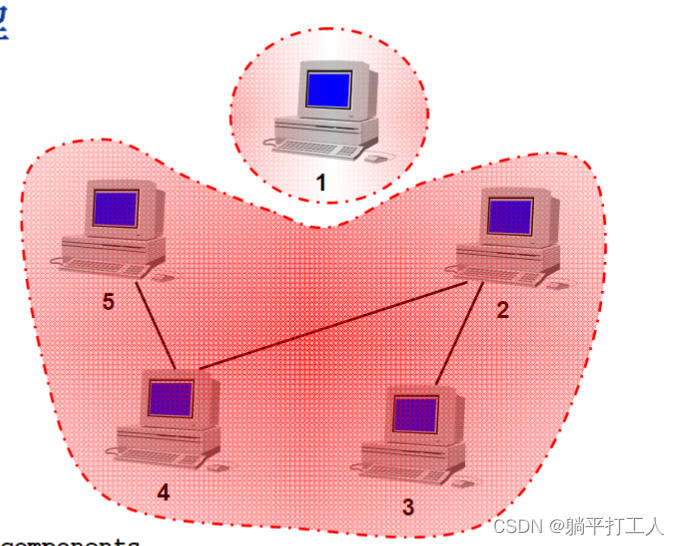
输出样例:

程序框架搭建:
int main() {
SetType S;
int n;
char in;
scanf("%d", &n);
Initialization(S, &n);//建立一个容量为n的集合
do {
scanf("%c", &in);
switch (in) {
case 'I':Input_connection(S); break;//建立连接
case 'C':Check_connection(S); break;//检查是否连接
case 'S':Check_network(S, n); break;//检查有几个net
}
} while (in != 'S');
return 0;
}
方法实现
SetName Find(SetType S, ElementType X) {//查找某个元素的根节点
for (; S[X] >= 0; X = S[X]) {
//默认集合元素全部初始化为-1
return X;
}
}
void Union(SetType S, SetName Root1, SetName Root2) {
//这里root1和root2是不同节点的根节点
S[Root2] = S[Root1];
}
void Input_connection(SetType S) {
ElementType u, v;
SetName Root1, Root2;
scanf("%d %d\n", &u, &v);
Root1 = Find(S, u - 1);
Root2 = Find(S, v - 1);
if (Root1 != Root2) {
Union(S, Root1, Root2);
}
}
void Check_connection(SetType S) {
ElementType u, v;
SetName Root1, Root2;
scanf("%d %d\n", &u, &v);
Root1 = Find(S, v - 1);//计算机的编号为1,2....n映射到集合上为0,1....n-1.故传入的数据应为u-1
Root2 = Find(S, v - 10);
if (Root1 == Root2) {
printf("Yes\n");
}
else {
printf("No\n");
}
}
void Check_network(SetType S, int n) {
int i, counter = 0;
for (i = 0; i < n; i++) {
if (S[i] < 0)counter++;
}
if (counter == 1) {
printf("The network is connected.\n");
}
else {
printf("There are %d components.\n", counter);
}
}在PTA上的运行结果:
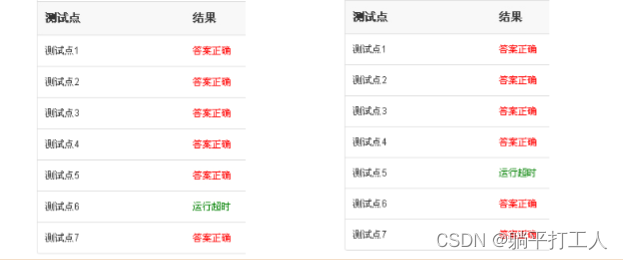
运行超时原因分析:
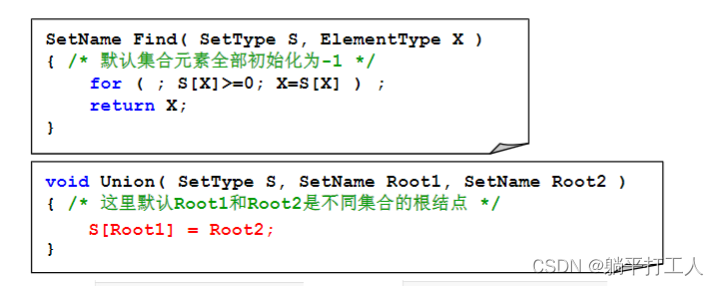

把高的树插到矮的树上会导致树的高度不断变高,随着集合的不断合并,树高不断增大,因而查找的次数也不断增多,导致超时。
解决方案:按秩归并
方法1:
void Union(SetType S, SetName Root1, SetName Root2) {
if (S[Root2] < S[Root1]) //S[Root]=-树高
S[Root1] = Root2;
else {
if (S[Root1] == S[Root2]) S[Root1]--;//树高加1
S[Root2] = Root1;
}
}方法2:
void Union(SetType S, SetName Root1, SetName Root2) {
if (S[Root2] < S[Root1]) {
S[Root2] += S[Root1];
S[Root1] = Root2;
}
else {
S[Root1] += S[Root2];
S[Root2] = Root1;
}
}路径压缩
图示:
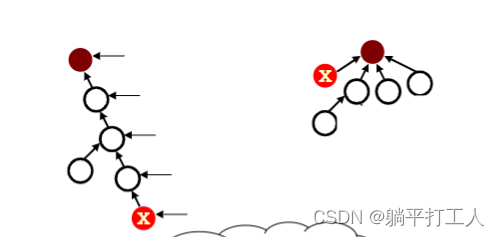
SetName Find(SetType S,ElementType X){
if(S[X]<0)
return X;
else
return S[X] = Find(S,S[X]);
}